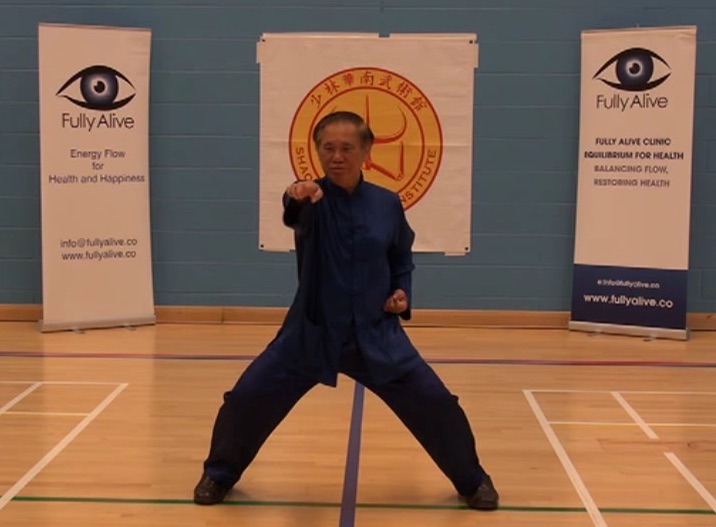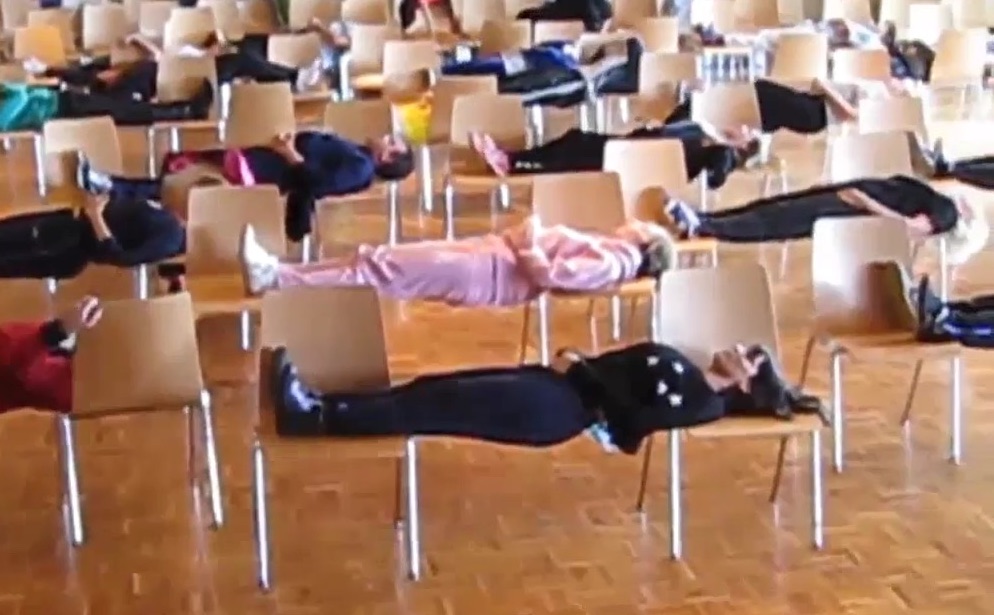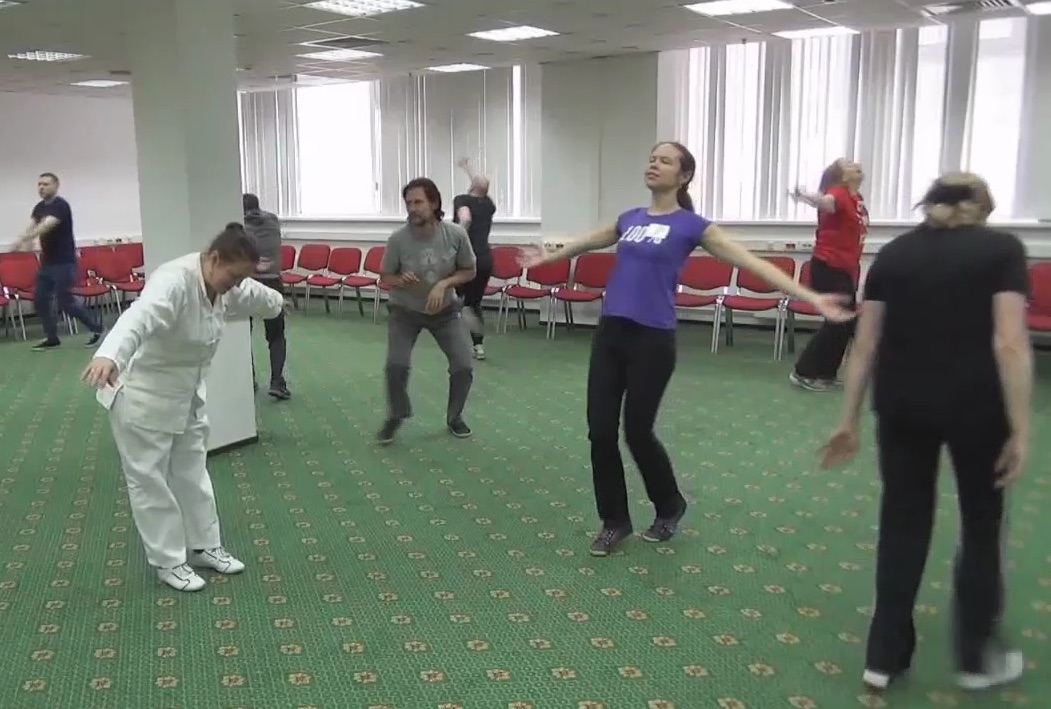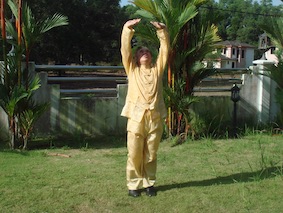SELECTION OF QUESTIONS AND ANSWERS
NOVEMBER 2020 PART 3

One-Finger Shooting Zen
Question 1
I notice and appreciate the incredible cost effectiveness of our arts even more. With just half an hour of Kung Fu and 10 minutes of Chi Kung I can enjoy all the benefits these arts provide! For this I am deeply grateful, keeping you, my Sifu and my Sigung in my prayers.
Our little baby girl of seven months is a true bundle of joy. She has not been sick once. Her complexion is rosy and the volume of her voice astonishing. I attribute much of this to our practise of the Shaolin Arts and our good Chi Flow. Thank you very much!
— Dr Steffen Wankmuller, Germany
Answer
One of the wonderful benefits we have is cost-effectiveness. If you are twice as effective as other people, that is quite remarkable. I remember that when I was a school teacher many years ago, I used to tell my colleagues that they earned double income if their wives were also working.But you are not 2 times, or 3 times or 4 times more effective; you are 16 times more effective. In other words, you are now 16 times more effective than when you did not practice genuine chi kung and genuine kungfu, and 16 times more effective than other people, which means the great majority, who do not practice genuine chi kung and genuine kungfu. It is just incredible.
How do I work out 16 times? If a person is distracted, he will perform better if he is focused. If he is tensed, he will perform better if he is relaxed. If he has no internal force, he will perform better if he has internal force. If he has no mental clarity, he will perform better if he has mental clarity. Now you have all these factors -- being focused, being relaxed, have internal force and have mental clarity.
It is not just 4 times. Because of exponential progression it is 16 times. If a person earns 4,000 euros a month, now he earns 64,000 euros. If he performs a daily task in 16 hours, now he performs the same task in an hour. It is true that "when one is accomplished in genuine Shaolin arts, it is better than changing stones to gold by touch."
But genuine Shaolin arts are very rare today. Many so-call chi kung practitioners are weak and sick. Many so-called kungfu practitioners cannot use their kungfu for defence.
Question 2
I have been focussing on One Finger Shooting Zen for a while and would like to continue to do so in order to train the force and skills for dim mark. In addition, I also enjoy the Dragon Strength Set tremendously.
What would be the best way to train both? Should I rotate them, or also rotate other methods like Golden Bridge, Cotton Palm and Fierce Tiger Cleanses Claws?
It is an honour to be part of your lineage and the Shaolin Wahnam family.
Answer
One-Finger Shooting Zen is a wonderful exercise. I do it every day. It will contribute to your good health, vitality, longevity, peak performance and spiritual joys. The One-Finger Zen of One-Finger Shooting Zen is trained for "dim mark", which is now considered a lost art though many people in Shaolin Wahnam know it. Once awhile you can test your dim mark with an unsuspecting victim, but you must draw out the injury.
You can perform One-Finger Shooting Zen and then Dragon Strength. Once awhile you may rotate it with other arts, like Golden Bridge, Cottom Palm and Fierce Tiger Cleanses Claws. Another wonderful benefit of our arts is that when you practice Golden Bridge or Cotton Palm, for example, you contribute to your health, vitality, longevity, peak performance and spiritual joys.

Iron Plank Bridge
Question 3
I have started to practice "Iron Plank Bridge" which I learned from you in the Legacy of Ho Fatt Nam Course in Switzerland.
Are there any important points to take into consideration while training "Iron Plank Bridge" on a regular basis?
What is a good basic/intermediate/advance standard in terms of time of practice?
What are the expected results after 3, 6 and 12 months of continued practice?
I'm using a pair of stools as support for "Iron Plank Bridge". Stools can be used as a weapon. Do we have in Shaolin Wahnam any kung fu set like the Umbrella Set?
— Angel, Spain
Answer
"Iron Plank Bridge" is a secretive art. I believe my sifu, Sifu Ho Fatt Nam, only taught it to me. It is very powerful, and produces a lot of internal force which can be used daily.
If you wish to practice on a regular basic, set your aims and objectives, and work towards them. For example, you may aim to have good health and vitality, and the objective to run round a football field without panting.
You must set time to practice your chosen art every day, in this case "Iron Plank Bridge". You must gurad against "yit shue sap hon" (Cantonese Chinese) which may be traslated as "one hot ten cold", or practice just once awhile, which is the reason why people do not succeed when when they have good methods and good teachers.
There is no time limit of "Iron Plank Bridge" for basic, intermediate and advanced levels. But it is very important to progress gradually. Remember that a typical Shaolin Wahnam student can achieve in a month what I would need a year in my student's days, and I was already a very good student. After learning from Sifu Ho Fatt Nam, I could beat professional fighters and masters.
It is difficult to estimate the result for basic, intermediate and advanced levels, or after 3, 6 and 12 months. What is sure is that you will have a lot of internal force. Very, very few people would want to spar with you.
You can use a stool as a weapon. For example, you can use the legs of a stool to disarm an opponent, or to strike him. You must not take any chance when fighting with someone holding a weapon, or an improvised weapon. I learned or "stole" in Kungfu terminology two stool sets, one from Uncle Righteousness and the other from Sifu Choe Hoong Choy, but I have forgotten them.
Question 4
Some students keep tensing up when it comes to partner exercises like combat sequences in our Tai Chi Chuan training. I have tried the following instructions:
"Do it slower" ... and progress to more speed and force later.
"Do it like a dance." ... although Tai Chi is not a dance.
"Go to chi flow first" ... while in poise pattern.
Could you please comment on these methods and add any further advice?
— Sifu Leonard Lackinger, Shaolin Wahnam Austria
Answer
It is recommended that students who tense up during any exercise is to take some deep breaths and sink their energy into the dan tian, or abdominal energy field.
The instructions you give -- "do it slower", "do it like a dance", "go to chi flow first" -- are very good.
Some good advice is to check the students' breathing. Let them breathe slowly and sink their energy into their dan tian.
But remember that students take time to learn these techniques.

Go to chi flow
Question 5
While the name of "Lifting the Sky" seems obvious when seeing its movements, one of my students asked if there is some poetic, philosophical or historical meaning to it too.
Answer
"Lifting the Sky" exercises the triple-warmer and sends chi to all parts of the body. The upper warmer is from the throat to the solar plexus, the middle warmer from the solar plexus to the naval, and the lower warmer from the naval to the anus.
In Chinese Medicine, the triple warmer is very important. A tell-tale sign of its weakness is that a person has little voice.
A poetic or philosophical saying is "Lifting the Sky takes care of the triple warmer". You can speak loudly without the aid of a microphone because your triple warmer is strong.
Question 6
Often, in meditation I experience a thought layer that is often called the "observer". While I let go of any unnecessary thoughts and experience stillness of mind, at least for a few seconds, often this observing voice that notices the stillness is still coming up. I don't let it produce any further thoughts, analysis or intellectualization. Still, I was wondering if we should strive for perfect stillness, including silencing this observer voice.
Is the "observer" our awareness?
Could you please elaborate on the "observer" and the various stages of attainment in mediation?
Answer
If we attain perfect stillness, we become Enlightened. Hui Neng, the 6th Patriarch, often regarded as a second Buddha, says "When a person is Enlightened, he becomes a Buddha. When a Buddha is unenlightened, he becomes an ordinary person."
The "observer" is our awareness.
There are two ways to Enlightenment -- the gradual way and the sudden way.
The gradual way takes life-times. Most people are lost; only those involved in spiritual cultivation embark on this progression.
An excellent approach in spiritual cultivation is " Si Chan Ba Ding", which may be translated as "Four Zen Eight Stillness". There are 8 meditative levels, not 12, because the 5th level, which is the start of the "Eight Stillness" continues from the first four, making 8 levels altogether.
These 8 levels are:
- Absence of desires.
- Joy.
- Non-attachment.
- Awareness beyond thought.
- Boundless space.
- Pure consciousness.
- Pure emptiness.
- Beyond perception and non-perception.
This sudden way, known as Zen in Buddhism, is advocated by the Sixth Partiarch, Hui Neng, who says that "When a Buddha is unenlightened, he is an ordinary person. When an ordinary person is enlightened, he becomes a Buddha."
In Buddhism, which is actually not a religion as many Westerners conceptualize what a religion is, Englightenment is merging with Cosmic Reality, known in Western terms as returning to God the Holy Spirit. It is prosaic in scientific terms. It is the undifferentiated spread of energy.

Lifting the Sky
Question 7
In Zhan Zhuang, we earlier had the method of counting breaths. Nowadays you prefer to don't think of anything to attain no-mind.
I also recall your advice to have a gentle focus on the Dantian. Counting breaths was an effective method to do that.
Answer
Gently focusing on the dan tian, or abdominal energy centre, while counting breaths is an excellent method. It will focus the energy at the dan tian, giving participants much internal force.
Counting breaths in zhan zhuang, or stance training, is phenomenal. Attaining no-mind, which is all-mind, is transcendental.
It is good to start with the phenomenal. Transcendental is for the advanced.
Question 8
When we clear our mind from all thoughts now, should we still keep the gentle focus on the Dantian and/or the breathing, but without counting?
Should fresh beginners do so already or should I add this internal aspect only later?
Answer
When we gently focus on the dan tian or the breathing, with or without counting, our thought is on the dan tian or breathing. Clearing the mind of all thoughts is to clear the mind of all thoughts, including the thought of focusing on the dan tian or breathing.
It is very difficult to clear the mind of all thoughts. The great majority of people have myriad thoughts coming to their mind. Focusing on the dan tian or on the breathing is an excellent way to train the mind. It is using one thought to represent hundreds of thoughts.
Clearing the mind of all thoughts is for advanced practitioners. Elementary and intermediate students should focus on their dan tian or on their breathing.
If you have any questions, please e-mail them to Grandmaster Wong via his Secretary at stating your name, country and e-mail address.
LINKS
Selected Reading
- Skills Transmitted by Grandmaster Ho Fatt Nam for Combat and Daily Life
- Frequently Asked Questions on Taijiquan
- One-Finger Shooting Zen of Shaolin Kungfu
- Mafra and Praia Grande
- The Oasis of Santa Fe
